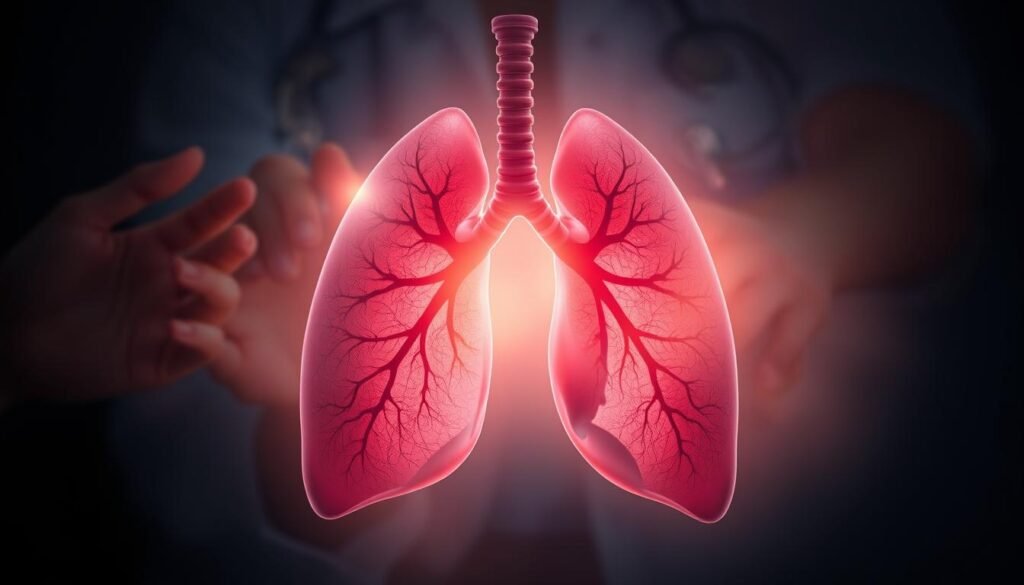Did you know only 15% of lung cancer patients survive beyond five years after their diagnosis? This fact shows the critical need for more than just traditional treatments. Focusing on lung cancer supportive therapy is key to enhancing the lives of those impacted. It involves palliative care, symptom control, and emotional help suited to their unique needs during treatment.
This article will look into how supportive therapy for lung cancer helps. It reduces physical discomfort and boosts emotional wellness for patients and their families. Early discussions about palliative care are crucial and can greatly improve life quality despite lung cancer’s challenges.
Key Takeaways
- Lung cancer supportive therapy offers services to better life quality.
- At any lung cancer stage, palliative care can help, not just at the end.
- Keeping weight stable may link to longer survival for lung cancer sufferers.
- Supportive therapy can manage symptoms like pain and fatigue well.
- For lung cancer patients, emotional and psychological support is key to their well-being.
Understanding Lung Cancer and Its Impact on Quality of Life
Lung cancer leads in causing major health problems worldwide. It poses big challenges not just with lung cancer statistics. It also deeply affects patients’ quality of life. This section looks at these numbers. It also talks about the emotional and physical hardships people with this disease face.
Overview of Lung Cancer Statistics
In the United States, lung cancer is behind more than 219,000 new cases each year. It’s among the top cancers diagnosed. Sadly, its 5-year survival rate is only about 15%. This means many patients find out they have it when it’s advanced. This makes treating it harder. These lung cancer statistics show how crucial early detection is. It can help patients get better and support their well-being.
The Importance of Quality of Life in Lung Cancer Patients
Lung cancer affects more than just physical health. Patients face emotional and social problems too. These issues can greatly reduce their quality of life. Symptoms like tiredness and breathing trouble impact their daily lives and relationships. Research says that good palliative care can make a big difference. It helps with physical, mental, and social needs. This underlines the need for care plans that address all aspects of a patient’s needs. For a deep dive into the mental aspects, check here.
What is Lung Cancer Supportive Therapy?
Lung cancer supportive therapy improves the experience for patients with this tough diagnosis. It covers symptom management and emotional support. These elements are vital during the treatment journey.
Defining Supportive versus Palliative Care
It’s important to know the difference between supportive and palliative care. Both aim to make life better for patients. Yet, supportive care offers a wider range of help. It tackles physical, emotional, and practical issues caused by lung cancer and its treatments.
Palliative care focuses on easing symptoms and suffering in advanced disease stages. Both are key in providing full care, aiming to enhance well-being.
Goals of Lung Cancer Supportive Therapy
The main goals of lung cancer supportive therapy are about bettering life quality. They aim to:
- Reduce pain and control different symptoms of lung cancer.
- Give emotional support to patients and their families during this tough time.
- Make sure patients and doctors talk well, ensuring care goals are achieved.
- Promote exercise and good nutrition for better health.

Benefits of Lung Cancer Supportive Therapy
Lung cancer supportive therapy helps improve life quality for patients and families. It deals with physical symptoms management, psychological well-being, and family support. Supportive care is priceless for those facing lung cancer challenges.
Improving Physical Symptoms
Many patients suffer from pain, fatigue, and breathlessness. Supportive therapy aims to reduce these problems. Treatments like systemic opioids work well for breathlessness. Managing physical issues helps patients enjoy better daily lives and satisfaction.
Enhancing Psychological Well-Being
Lots of lung cancer patients feel psychological distress. Supportive therapy includes counseling and stress management interventions. Techniques such as Cognitive Behavioral Therapy (CBT) assist with anxiety and depression. Telehealth services also make mental health support more accessible.
Supporting Families and Caregivers
Family support is very important. Caregivers feel stress while helping their loved ones with lung cancer. Supportive therapy offers resources and educational programs for families. This approach supports family healing by providing needed assistance.
| Supportive Therapy Benefit | Description |
|---|---|
| Physical Symptoms Management | Alleviates issues such as pain and breathlessness through targeted treatments. |
| Psychological Well-Being | Provides counseling and therapy options to manage emotional distress. |
| Family Support | Offers resources and education for caregivers to ease their emotional burden. |
| Enhanced Quality of Life | Integrates physical and emotional aspects of care for improved overall well-being. |
Supportive therapy covers the needs of lung cancer patients and families thoroughly. By understanding the benefits of supportive therapy, healthcare workers can better the lives of all involved.
Symptom Management in Lung Cancer Patients
Lung cancer is tough on people’s quality of life. Those diagnosed face many symptoms that need managing. If managed early, their well-being can significantly improve.
Common Symptoms of Lung Cancer
Chronic cough, dyspnea, and severe fatigue are common in lung cancer. A chronic cough can mess with everyday life. Dyspnea makes it hard to move around and feel comfortable doing it. Fatigue hits hard too, making even simple tasks seem impossible.
Treating Pain and Fatigue
Managing pain is vital in lung cancer care. Patients often need a custom plan for their pain, including different strong painkillers and other meds for nerve pain. Doctors might also give meds to help with the fatigue. With a good management plan, patients can do more of their daily activities.
Managing Respiratory Issues
Respiratory therapy is key for lung cancer-related breathing problems. Techniques like breathing exercises and extra oxygen can help ease breathing. Talking with doctors helps find the best ways to manage symptoms. This leads to better care overall.

| Symptom | Treatment Options | Management Strategies |
|---|---|---|
| Chronic Cough | Cough suppressants, Bronchodilators | Regular monitoring, Lifestyle adjustments |
| Dyspnea | Supplemental oxygen, Respiratory therapy | Breathing exercises, Positioning techniques |
| Fatigue | Stimulants, Pain management medications | Pacing activities, Sleep hygiene |
| Pain | Sustained-release opioids, Adjuvant medications | Regular assessments, Multidisciplinary care |
Using different methods to manage symptoms helps lung cancer patients live better. It helps them handle their condition more easily.
The Role of Palliative Care in Lung Cancer Treatment
Palliative care improves the lives of lung cancer patients by taking a whole-person approach. It focuses on full care that looks at medical, emotional, and psychological needs. Offering palliative care early can make life better and help patients understand their health better.
Comprehensive Approach to Patient Care
A comprehensive approach in palliative care means different healthcare providers work together. They include oncologists, nurses, and social workers. This teamwork makes sure patients get complete evaluations and support for severe symptoms and stress.
Palliative care puts patients first. It helps reduce problems like pain, trouble breathing, and emotional distress.
Collaboration with Oncologists and Healthcare Teams
Working together, palliative care specialists and oncologists make lung cancer treatment better. Regular talks help shape care that eases symptoms and plans for the future. Studies show patients with both palliative and standard care live longer than those with standard care alone. This shows how important full palliative strategies are in making patients’ lives better. For personalized lung cancer treatment, seeing top oncologists helps; more info is available here.

Psychosocial Support for Lung Cancer Patients
Getting diagnosed with lung cancer is really tough. About 80% of these patients feel a lot of stress. This stress shows why psychosocial support is so crucial in their care. This kind of support lets patients share what they’re going through. It really helps cut down on feeling alone during this hard time.
Understanding the Importance of Emotional Support
Studies say lung cancer patients often want psychosocial support from nurses when they find out they’re sick. They prefer it over getting this support from other health pros. This shows we need care that looks after their emotional needs just as much as their medical needs. Cognitive behavioral therapy (CBT) is a big help for dealing with depression and anxiety, which a lot of lung cancer patients feel. We need to make sure these mental health treatments are a part of their care to help them feel better.
Community Resources and Support Groups
Community resources like support groups and counseling are key. They help a lot. These resources give patients a place to share their struggles with people who understand. Studies show that those who have access to these resources cope better and feel less stressed. Yet, finding good psychosocial care is hard. There’s a big difference in care quality between cities and smaller towns. We need to fight for better support everywhere.
Nutritional Therapy and Its Significance
Nutritional therapy is crucial for lung cancer patients. It helps fight the side effects of treatment. Eating well improves energy levels and immune function.
Maintaining Nutrition During Treatment
Lung cancer patients need tailored nutrition plans. These plans help meet their dietary needs. Dietitians who focus on lung cancer are very helpful.
- Consulting with registered dietitian nutritionists specialized in lung cancer dietary needs.
- Incorporating antioxidants like vitamin A, C, E, selenium, and zinc, which enhance the body’s defenses.
- Utilizing omega-3 fatty acids from fish to help regulate inflammation and inhibit tumor growth, particularly during chemotherapy and radiotherapy.
Combating Weight Loss and Cachexia
Handling cachexia is key for cancer patients. It involves managing weight loss and muscle wasting. Working with healthcare teams helps manage side effects well.
Here are some dietary tips for handling treatment side effects:
- Choosing bland foods that are easier to digest.
- Getting assistance with meal preparation from friends and family.
- Participating in forums such as the Inspire Lung Cancer Online Support Community for peer support and shared experiences.
| Nutritional Element | Benefits | Sources |
|---|---|---|
| Omega-3 Fatty Acids | Regulates inflammation, reduces chemotherapy toxicity | Fish, flaxseeds, walnuts |
| Antioxidants | Strengthens antioxidant barrier, improves immune response | Fruits, vegetables, nuts |
| Protein | Supports muscle mass, enhances recovery | Lean meats, dairy, legumes |
Using resources like the Lung HelpLine or the Patient & Caregiver Wellness Hub is beneficial. A holistic approach is essential for better outcomes in lung cancer patients.
Complementary Therapies in Lung Cancer Care
Complementary therapies are key in helping lung cancer patients. They boost the quality of life by meeting physical and emotional needs. Patients often try therapies like mindfulness and massage to ease symptoms and discomfort.
Exploring Integrative Approaches
There are many complementary therapies for patients to try. They can pick what works best for them. Here are some options:
- Acupuncture: Known for its ability to relieve pain, acupuncture may provide significant benefits for lung cancer patients.
- Massage therapy: This therapy promotes relaxation and helps patients unwind during challenging times.
- Reflexology: A practice from Chinese medicine, reflexology may offer additional benefits for lung cancer patients.
- Reiki therapy: Involves the gentle touch of life energy to aid in healing and relaxation.
- Tai Chi: This peaceful form of exercise can enhance relaxation and physical well-being.
- Mindfulness and meditation: Practices that can reduce anxiety and depression, improving sleep quality and emotional health.
- Yoga: Shown to lower inflammation, yoga aids in physical function and overall wellness.
Benefits of Mindfulness and Massage Therapy
Mindfulness and massage therapy have many benefits. People often feel more relaxed and less anxious after Reiki treatments. Mindfulness can reduce stress, helping patients deal with their diagnosis and treatment.
Complementary therapies add to standard treatments. They form a complete care plan. But, patients should talk to their doctors before trying new therapies. It’s important to know about things like cannabis oil, which might be illegal or expensive.
Conclusion
Lung cancer support therapy is key to improving life for patients and families. It helps with physical symptoms and emotional stress. It also ensures treatments work well together. This approach makes caring for lung cancer very patient-focused.
Support therapy does more than manage symptoms. It brings healthcare teams and community help together. This teamwork is vital for dealing with lung cancer.
Studies show many factors affect treatment choices. These include other health issues, how well a patient can do activities, and what they want. Knowing these helps find the best care for non-small cell lung cancer (NSCLC) patients. A report on support therapy also notes early palliative care leads to better life quality.
Having a complete lung cancer care summary highlights the need for support therapy. It’s essential in lung cancer management. By focusing on this important part of care, health providers offer the best support through the patient’s journey.